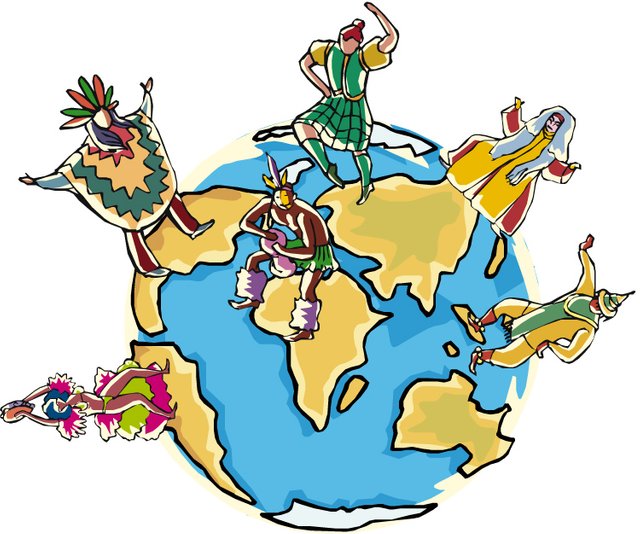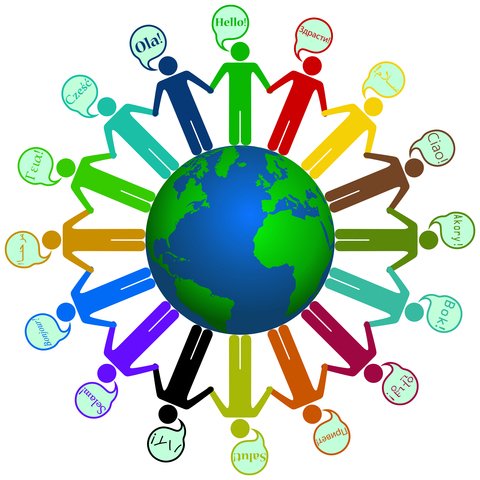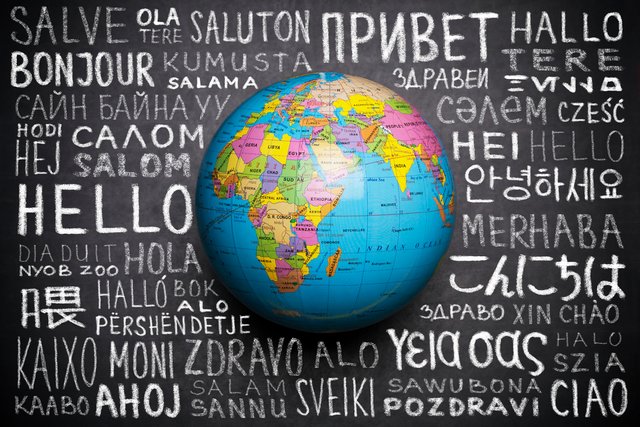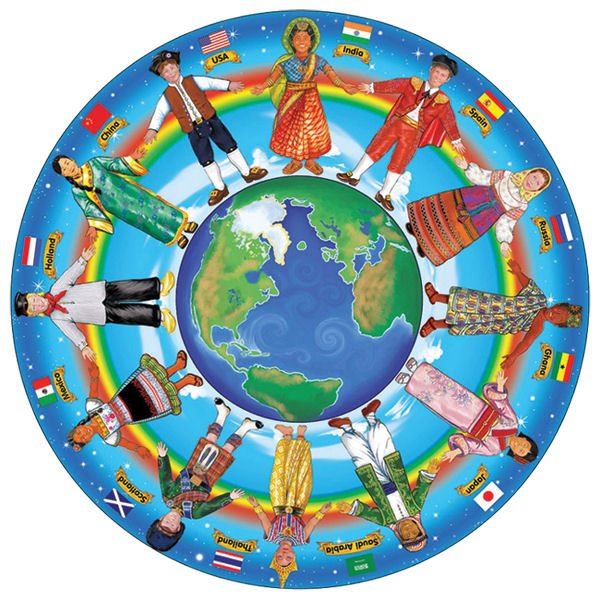
Communication: Part 2 - The anthropological study of language - The connection between language and culture
The anthropological study of language: The connection between language and culture
The study of language is important to anthropologists because knowledge of the language of a group of people is essential for the study of their social behaviour, culture and way of thinking. Language provides clues for understanding culture. A person generally talks about people, places and objects that are important to them. Thus the vocabulary of that person's spoken language may give us clues as to important aspects of his or her culture. Knowing the words that people use for things may give us a glimpse of how they understand the world.
Language is a system and has a structure. Each language consists of the following:
- speech sounds, which are combined into morphemes (the smallest unit of a language that is meaningful; for example, the word "dogs" consists of two morphemes, namely "dog" and "s").
- a collection of words called the vocabulary
- larger units of meaning, such as phrases and sentences, which are determined by the grammar of the language
Each morpheme and word has a standardised meaning that is recognised by the speakers of the language. The standardised meaning forms part of the semantic system of language, which also includes the knowledge that enables speakers of a language to understand the meanings of phrases and sentences and to communicate with one another.
It has been estimated that there are approximately 6000 languages in the world, excluding the many thousands that have become extinct over time. Some languages are written, others are not. There is nothing to suggest that, as is often believed, a language that is not written is inferior to one that is written. All languages serve the cultural needs of their speakers, whether they are written or not. Millions of people speak languages without written forms and many languages of so-called non-literate societies are among the most complicated in structure.
Language is part of all cultures and, as such, it is part of knowledge, beliefs and values that are transmitted to the next generation. Language also happens to be the most important medium through which this transmission occurs.
Langauge, and especially vocabulary, reflects what is important in a culture. In the English language we use many words relating to war when we describe other phenomena, such as "fighting" against AIDS epidemic, "battling" against old age, carrying out a "war" against poverty, and "shooting down" an argument. The Nuer of Sudan have more than 400 words and descriptions dealing with cattle. This gives us some indication of what is important to each society and, often, how they structure themselves.
From their study of kinship, anthropologists know that the way people name their in various societies reveals more than just the identity of a person. English contains words such as "mother", "father", "brother", "sister", "uncle", "aunt", "niece and so on. Other societies, however, have separate words for a younger or older brother, a father's sister, a mother's brother, a sister's son etc. On the other hand, in a number of societies, the word denoting "mother" is also used for the mother's sister(s), and one word could denote both a brother and a cousin. Such words provide information about family structure, the nature and degree of importance of relationships between relatives, and attitudes and behaviour towards relatives.
Consequently, by studying the language of a group including the objects or concepts that they name and how they talk, we can identify what is important in their culture and determine how they deal with it. If the belief system or body of knowledge of a culture requires the expression of abstract ideas, the language will provide ways of transmitting these ideas.
One method by which the relationship between language and culture can be investigated is to analyse the ways in which people categorise and classify their experiences and perceptions of the world. This approach is known as ethnosemantics or ethnoscience. Cross-cultural comparisons are made of semantic domains. These are classes of phenomena, that is, ideas, things or events, which are similar to each other in some way.
Examples of semantic domains that have been studied are kinship and colour terminologies. For instance, Conklin (1955) found that whereas in English, colour is classified according to hue, brightness and saturation (eg dark red, pale yellow, powder blue), the Hanunoo of the Philippines take into account features not considered in English, such as moisture, surface texture, lightness and association with plant life in their classification of colour.
A matter that continues to interest linguists and anthropologists is the effect of language on the perceptions and thought patterns of its speakers. Sapir (1921:228) believed that language and thought processes were very closely linked, and Whorf (1940:231) believed that language was not merely a vehicle for expressing ideas, but that it actually shaped these ideas. The so-called Sapir-Whorf hypothesis, therefore, states that language conditions its speakers to perceive reality in a certain way. According to this theory, different languages produce different patterns of thought. Despite wide acclaim, however, doubts have been expressed whether the influence of language on its speakers can really be that strong. It is, for instance, possible for speakers of a language to learn or invent new words, and vocabularies may be extended when necessary. Furthermore, it has been argued that if the Sapir-Whorf theory were correct, societies that speak closely related languages would have similar cultures. But this is not necessarily the case. Among Native Americans, for instance, the culture of the south-western Navaho differs considerably from that of other groups, such as the Hupa and Apache, although they speak variants of the same language. At the same time, the Navaho share many cultural similarities with groups that speak completely different languages. Lanham (1979:82) suggests a more moderate view, in which language is considered to influence rather than determine thought.
End of Part 2
Thank you for reading.
Images are linked to their sources in their description and references are stated below.
Authors and Text Titles
LW Lanham 1979:Language and a world view
E Sapir 1921: Language: An introduction to the study of speech
BL Whorf 1940: Science and linguistics
HC Conklin 1955: Southwest Journal of Anthropology
S Nanda & PL Warms 2004:Cultural ANthropology








Excelent post . Quite comprehensive . This is is one of the most detailed post I have read on steemit. Language and culture are interrelated. In some cultures , some objects can have different names according to their shape- Take the example of snow. For native people from Alaska, there are several words to describe snow just according to its shape ( falling snow, snow on the ground,etc, ect). For other languages there is only one word thatdefines snow. THanks. Great post .
Downvoting a post can decrease pending rewards and make it less visible. Common reasons:
Submit
Hi @francisaponte25
Thank you for the brilliant comment!!!!
Downvoting a post can decrease pending rewards and make it less visible. Common reasons:
Submit
Hi @zest! I'm really loving these posts! Culture, expression, and language is a fascinating topic to me.
I was abruptly introduced to how various people groups invent new words and change their vocabulary when I worked with people from Guatemala. For months I thought they spoke Spanish, until one of them finally convinced me that the others had no idea what I was trying to say to them. I thought he was joking, but then I learned that they actually spoke Q’anjob’al, Quiché, and Chuj, and they had a difficult time understanding each other.
Downvoting a post can decrease pending rewards and make it less visible. Common reasons:
Submit
Hi !!!!
This is a perfect example, I could have used this in my post!!!!
Downvoting a post can decrease pending rewards and make it less visible. Common reasons:
Submit
You received a 10.0% upvote since you are not yet a member of geopolis.
To read more about us and what we do, click here.
https://steemit.com/geopolis/@geopolis/geopolis-the-community-for-global-sciences-update-3
If you do not want us to upvote and comment on your posts concerning earth and earth sciences, please reply stop to this comment and we will no longer bother you with our love ❤️
Downvoting a post can decrease pending rewards and make it less visible. Common reasons:
Submit
Attention - One untypical compliment now: In addition to the well-written texts, I am always pleased with the sources used by yourself. :)
Downvoting a post can decrease pending rewards and make it less visible. Common reasons:
Submit
Yo @mountain.phil28:)
Thank you so much!!!!!
Downvoting a post can decrease pending rewards and make it less visible. Common reasons:
Submit
thanks for the courses you gave me, this is very useful for me. i am interested in this lesson. with to the diversity of our culture in Indonesia. various cultures of various tribes of our various languages are united in one container of unity .. i want to communicate with you about this I beg your knowledge @zest
Downvoting a post can decrease pending rewards and make it less visible. Common reasons:
Submit
Hi @nomor1:)
It will be my pleasure, please send me a DM on Discord username: zest#3020
Thank you for comment and support:)
Downvoting a post can decrease pending rewards and make it less visible. Common reasons:
Submit
I mean .. i want to study with you
Downvoting a post can decrease pending rewards and make it less visible. Common reasons:
Submit
I absolutely agree with you. As long as there's a communication between the parties involved, then the language has performed its function.
Nice piece buddy
Downvoting a post can decrease pending rewards and make it less visible. Common reasons:
Submit
Hi @samminator!!!!!!
As always thank you for the comment and support buddy!!!!
Downvoting a post can decrease pending rewards and make it less visible. Common reasons:
Submit
excellent post being anthropology the science that studies the physical aspects and social and cultural manifestations of human communities.
Downvoting a post can decrease pending rewards and make it less visible. Common reasons:
Submit
Thank you!!!
Downvoting a post can decrease pending rewards and make it less visible. Common reasons:
Submit
In pra modern world, anthropology was teaching on their society, learn from nature, how to keep and respect other by good way. that is
Downvoting a post can decrease pending rewards and make it less visible. Common reasons:
Submit
I agree @johnrenald, during the prehistory of man the societies culture was largely influenced by the environment they were situated in, and we gained knowledge by observing and interacting with nature:)
Thank you for the comment and support:)
Downvoting a post can decrease pending rewards and make it less visible. Common reasons:
Submit
Thank back, and So nice to know u to enlightening us by your post @zest :)
Downvoting a post can decrease pending rewards and make it less visible. Common reasons:
Submit
Excellent post and extremely informative on the concept of communication. We take for granted its importance as well as its background. Looking forward to the next installments!
Downvoting a post can decrease pending rewards and make it less visible. Common reasons:
Submit
Hi @akeelsingh:)
Thank you for the comment and support!!!
Downvoting a post can decrease pending rewards and make it less visible. Common reasons:
Submit
Best Post I found on steemit so far! Being a linguist I could much relate to it and understood each word!
Keep sharing more knowledge about language and culture! Semantics and pregmatics are my favourite subjects.
And I have been working on kinship analysis in subcontinent.
Downvoting a post can decrease pending rewards and make it less visible. Common reasons:
Submit
Hi @ayeshamaryam:)
I will be writing an entire series on Kinship next, may be you would like to chat - I am on discord if you like to send me a DM -Discord username: zest#3020
Thank you for the great comment and support!!!
Downvoting a post can decrease pending rewards and make it less visible. Common reasons:
Submit
Sure
I am new on steemit don't know what is Discord.
Downvoting a post can decrease pending rewards and make it less visible. Common reasons:
Submit
Hello @zest , you have explained excenlente subject of precise form for the understanding of all, as a doctor that I have had the opportunity to travel to help very small communities that have a unique language, I know there are many languages but I never thought in 2000. Thank you very much for the publication
Downvoting a post can decrease pending rewards and make it less visible. Common reasons:
Submit
Thank you:)
Downvoting a post can decrease pending rewards and make it less visible. Common reasons:
Submit
I couldn't agree more with other commentators. Very insightful and informative. I'd like to add a comment on the semantic domain, about the vocabulary to describe colors. In venezuelan spanish, for instance, we tend to use words that associate the color with familiar objects from the environment, sometimes jocously: chick yellow (amarillo pollito), olive green (verde oliva), or chicken s... (whatever color that might be).
It is also arguable whether language determines thought or at least informs it. There may be instances to support either claim and that's probably one of the reasons children's literature has been so scrutinized by those who believe that children will become whatever form of language they consume and if they consume plenty of children's lit, it better be uplifting, and this of course starts with very vocabulary that is used to construct the stories that are told.
In comparative lit and cultural studies, when we examine the sayings, for instance of the United Stated and Venezuela, we find interesting traits that somehow shape or speak of the mentality of each people. Americans, for instance, have historically favored an entrepreneurial attitude based on Poor-Chichard-like maxims (Diligence is the mother of good luck, God helps them that help themselves, leisure is time for doing something useful, etc.), while Venezuelans like to recite maxims that suggest a rather deterministic philosophy (Como vamos yendo, vamos viendo[we'll figure it our on the way]; uno propone, pero Dios dispone [one proposes, God decides]; el apuro trae cansancio [hurry brings tireness], etc.).
I find this fascinating. Thanks for the quality posts.
Downvoting a post can decrease pending rewards and make it less visible. Common reasons:
Submit